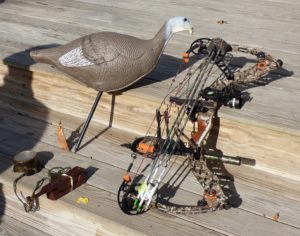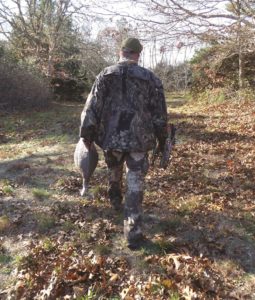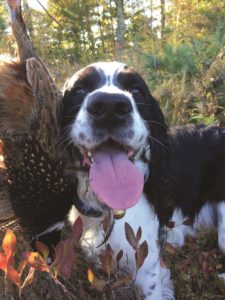EASTHAM — It’s an unusually warm Saturday in November. The noontime sun shines, and the air is still, when Jim McGrath lets out a turkey call in a remote, wooded part of Eastham.
After about 10 minutes, we walk to a different location. More calls, but no turkeys call back. This goes on for a while longer, before we drive to a different area of town.
We repeat the process, but our midday turkey hunt ends with no success.
The range of fall turkey hunting seasons in Massachusetts depends on where you live. The state is broken into zones. The Outer Cape is in zone 12, where hunters, only using archery equipment, can go after turkeys from Oct. 5 to 17 and Nov. 2 to 28. Shotgun bird hunting is allowed from Oct. 19 to 31. Hunting on Sundays is prohibited.
McGrath and his son Jake hunt turkeys regularly on the Outer Cape during the fall and spring seasons. They also hunt deer off Cape — I traveled with them to Western Mass. for an expedition last year.
I have asked Jim to let me follow him around on Saturday, as the turkey season begins to wind down. Every hunter has his own favorite spots, and Jim takes me to two in Eastham near the National Seashore.

Camouflage attire is a must. I am decked out in a camo jacket, hat, pants, face covering, and gloves. Turkeys might not be the smartest animal on the planet, but they’re highly sensitive to movement, so it’s best to be disguised in the woods.
McGrath brings his bow, a decoy turkey, and three different turkey calls to try to get the birds’ attention — diaphragm calls, pot and striker calls, and box calls, each making a slightly different sound. Box calls and pot and striker calls are worked by hand, while diaphragm calls use a piece of U-shaped rubber that’s placed on the roof of your mouth.
The diaphragm call makes a gentler sound. McGrath says it’s used when the bird is close by, so it doesn’t get too startled.
Fall and spring turkey hunts are much different, McGrath says. In the fall, male turkeys, known as mature toms, are more likely to be roaming together, while mother hens roam with their young.
“In the fall, you’re walking through the woods looking for a flock,” McGrath says. Hunters either use calls to try and locate a flock or roam the woods looking for tracks, eaten acorns, or dug up leaves — signs of turkey activity.
If a flock appears, McGrath says, there are two ways to proceed. One is to ambush the flock and take your shot on the ground or as a turkey flies up in the air. McGrath says that, using a bow, it’s extremely difficult to hit a turkey in the air.
Another way is to break the flock apart and single out younger turkeys.

“When danger is near, they’ll put out a clucking noise and sometimes run or fly,” McGrath says. “When the flock breaks up, the kids get nervous and wait to hear from the mother hen.”
The mothers will put out a call to collect their young. With the right call, you can trick the young turkeys.
“You can try to be the boss hen and call the young to you,” he says.
Springtime is mating season for turkeys, so the males are very talkative as they attempt to attract a female. Hunters then use calls to communicate with the turkeys, posing as a mature tom or female hen to lure them closer.
There’s another bird that’s popular with hunters on the Outer Cape. The Mass. Dept. of Fish and Game stocks pheasants in parts of the National Seashore, such as the Provincetown dunes and the Marconi area in Wellfleet. This happens weekly during hunting season, which runs from Oct. 17 to Nov. 28.
Eastham resident Sadie Hill has been hunting pheasants on the Outer Cape for the last 10 years. Her hunting partners, an Irish setter named Tuka and an English springer spaniel named Murphy, track down the birds.
It’s a different kind of bird hunting. Shotguns are almost always used, and most hunters don’t use calls but rather train a dog to be either a flusher or pointer. A flusher will sniff out the bird and then chase it, forcing it to take flight. A pointer will lock up when the pheasants are near and point his noise in the direction of the bird.

“Pheasant hunting is more about the relationship you create with your dog,” Hill says.
The wild turkey population in Massachusetts has expanded since the 1970s, when 37 wild turkeys captured in the Adirondacks in New York were released in Berkshire County, according to the National Audubon Society.
McGrath, who’s been hunting in Massachusetts his whole life, says that in the 1990s the state chapter of the National Wild Turkey Federation moved turkeys from Western Mass., where they were overpopulating, to the Cape. Ever since, the turkey population on the Outer Cape has increased.
The National Seashore plans to phase out the stocking of pheasants by 2024. Hill says she doesn’t think that will affect the number of pheasant hunters locally, because most will frequent stocked areas outside the Seashore, such as Duck Harbor or the woods off High Toss Road in Wellfleet.
Both the McGraths and Hill enjoy eating what they’ve killed at the end of the day. The McGraths make turkey pot pie, while Hill says her family usually freezes the pheasant meat, then breasts the pheasant and cooks it using chicken recipes.
